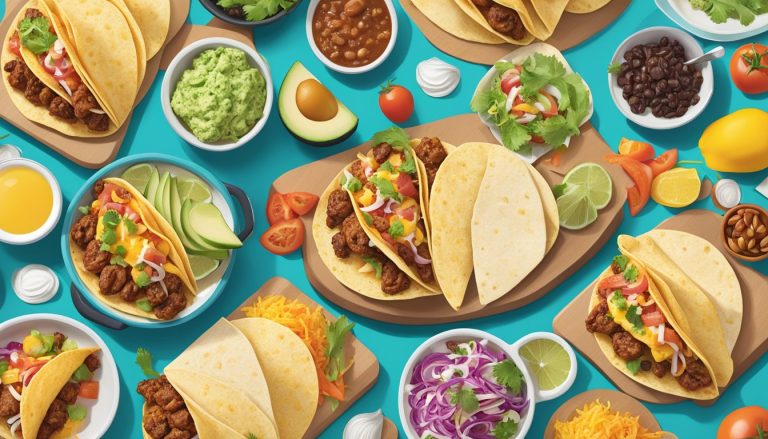Taco Cabana’s breakfast salsas elevate the morning taco experience with their vibrant flavors and authentic Mexican roots. These zesty condiments are crafted to complement the restaurant’s popular breakfast tacos, infusing each bite with a burst of Tex-Mex flair. Taco Cabana’s commitment to using fresh ingredients and traditional techniques ensures that their breakfast salsas capture the essence of Mexican cuisine while catering to Tex-Mex taste preferences.
The art of crafting these breakfast salsas lies in the careful balance of heat, acidity, and savory notes. Roasted tomatoes and jalapeños form the base of many of Taco Cabana’s salsas, creating a rich, smoky flavor profile that pairs perfectly with eggs, chorizo, and other breakfast taco fillings. The addition of cilantro, onions, and lime juice adds layers of complexity, resulting in salsas that awaken the palate and enhance the overall taco experience.
Taco Cabana’s breakfast salsas showcase the restaurant’s dedication to providing authentic flavors in a fast-casual setting. By offering a variety of salsa options, from mild to spicy, Taco Cabana allows customers to customize their breakfast tacos according to their personal preferences. This attention to detail and focus on flavor has helped establish Taco Cabana as a go-to destination for those seeking a satisfying and flavorful Tex-Mex breakfast.
History and Origin of Taco Cabana Breakfast Salsas

Taco Cabana’s breakfast salsas have deep roots in Texas culinary tradition. These flavorful condiments reflect the rich tapestry of Tex-Mex cuisine and the vibrant food cultures of San Antonio and Austin.
Influence of San Antonio and Austin
San Antonio played a crucial role in shaping Taco Cabana’s breakfast salsas. The city’s strong Mexican-American heritage infused authenticity into the recipes. Local ingredients and traditional cooking methods influenced the salsas’ development.
Austin’s innovative food scene also contributed to the evolution of Taco Cabana’s breakfast salsas. The city’s penchant for culinary experimentation encouraged the chain to create unique flavor profiles. This blend of tradition and innovation set Taco Cabana’s salsas apart from competitors.
Tex-Mex Tradition and Evolution
Taco Cabana’s breakfast salsas draw heavily from Tex-Mex culinary traditions. The chain incorporated classic ingredients like jalapeños, tomatoes, and cilantro into their recipes. These elements pay homage to the long-standing breakfast taco culture in Texas.
Over time, Taco Cabana adapted its salsas to meet changing tastes. The company introduced new varieties to complement its expanding breakfast menu. This evolution ensured that Taco Cabana’s breakfast salsas remained relevant and appealing to a diverse customer base.
The Basics of Salsa Making
Crafting delicious salsas requires understanding key ingredients and techniques. Fresh produce, proper preparation methods, and balanced flavors are essential for creating authentic Mexican-inspired salsas.
Understanding Salsa Ingredients
Salsa ingredients typically include tomatoes, onions, chili peppers, and garlic. Fresh produce is crucial for achieving the best flavor and texture. Tomatoes provide a base for many salsas, while onions add sharpness and depth.
Chili peppers contribute heat and can vary from mild to extremely spicy. Common varieties include jalapeños, serranos, and habaneros. Garlic enhances the overall taste profile with its pungent flavor.
Salt is essential for bringing out the natural flavors of the ingredients. Some recipes may include additional spices like cumin or oregano for complexity.
Salsa Verde and Salsa Roja
Salsa verde and salsa roja are two classic Mexican salsa varieties. Salsa verde uses tomatillos as its base, giving it a tangy, bright flavor. Key ingredients include:
- 10 tomatillos, husked and rinsed
- 2-3 jalapeños or serrano peppers
- 1 small onion, chopped
- 2 garlic cloves, minced
- 1/4 cup fresh cilantro, chopped
Salsa roja, on the other hand, is tomato-based and has a deeper, richer flavor. It often includes roasted tomatoes, which add a smoky element to the salsa.
The Role of Cilantro and Lime
Cilantro and lime are crucial components in many Mexican salsas. Cilantro adds a fresh, herbaceous note that complements the other ingredients. It’s typically chopped finely and added near the end of preparation to preserve its flavor.
Lime juice provides acidity, which balances the heat from peppers and enhances the overall taste. It also helps to preserve the salsa’s freshness. The amount of lime used can vary depending on personal preference and the other ingredients in the salsa.
Both cilantro and lime contribute to the bright, zesty flavors associated with authentic Mexican salsas. They work together to create a harmonious blend of tastes that elevate tacos, chips, and other dishes.
Creating the Perfect Breakfast Taco Complement

Crafting the ideal complement for breakfast tacos requires balancing flavors and matching salsas to specific taco ingredients. The right salsa can elevate a simple breakfast taco into a memorable morning meal.
Balance of Flavors
Breakfast tacos often feature eggs, potatoes, refried beans, and cheese. A well-crafted salsa should enhance these flavors without overpowering them. Mild tomato-based salsas work well with egg-centric tacos, providing a fresh contrast.
For tacos with heartier fillings like potatoes or beans, a spicier verde salsa can cut through the richness. Onions in the salsa add a sharp bite that wakes up the palate.
Texture is key. Chunky salsas offer satisfying contrast to soft scrambled eggs, while smoother varieties blend seamlessly with refried beans.
Matching Salsas with Breakfast Tacos
Different breakfast taco fillings pair best with specific salsas. Egg and cheese tacos benefit from a classic pico de gallo, which adds freshness and a hint of heat.
Potato and chorizo tacos stand up well to bolder salsas, such as chipotle or habanero varieties. The smokiness complements the savory meat and starchy potatoes.
Bean and cheese tacos shine with a tangy tomatillo salsa. Its acidity cuts through the creamy textures.
For veggie-packed breakfast tacos, a roasted tomato salsa brings depth without overshadowing the vegetables. It enhances rather than competes with the ingredients.
Salsa Varieties and Their Components

Taco Cabana’s breakfast salsas offer a diverse range of flavors and textures to complement their morning menu. These salsas showcase traditional Mexican ingredients and techniques adapted for the breakfast table.
Pico de Gallo
Pico de gallo is a fresh, chunky salsa that adds a burst of flavor to breakfast tacos. It consists of diced tomatoes, white onion, and cilantro as its base. Minced jalapeños or serrano peppers provide a mild heat.
A squeeze of lime juice brightens the flavors and adds acidity. Salt enhances the overall taste. Some variations include diced bell peppers or cucumber for extra crunch.
Pico de gallo is typically served cold or at room temperature. Its freshness pairs well with eggs, potatoes, and breakfast meats.
Jalapeño Salsa
Jalapeño salsa brings a spicier kick to breakfast dishes. Roasted jalapeños form the foundation of this salsa, providing a smoky heat. Tomatillos are often added for tartness and body.
Garlic and onion contribute savory notes. Cilantro adds freshness. The ingredients are blended to create a smooth consistency.
This salsa can range from mild to hot, depending on the jalapeños used. It complements chorizo and egg dishes particularly well.
Avocado-Based Salsas
Avocado-based salsas offer a creamy texture and rich flavor. Guacamole is the most well-known variety. It combines mashed avocados with diced tomatoes, onions, and cilantro.
Lime juice prevents browning and adds zest. Garlic and jalapeños provide depth and heat. Salt enhances the flavors.
Some variations include tomatillos for a tangier profile. Others incorporate roasted peppers for smokiness.
These salsas pair excellently with breakfast burritos and migas. They also serve as a cooling counterpoint to spicier dishes.
Distinguishing Between Salsas and Other Mexican Condiments

Mexican cuisine offers a variety of flavorful condiments that enhance dishes. Salsas, guacamole, sour cream, and Tex-Mex sauces each have distinct characteristics and uses.
How Salsa Differs from Guacamole and Sour Cream
Salsa is a tomato-based sauce with various ingredients like onions, peppers, and cilantro. It ranges from mild to spicy and has a chunky or smooth texture. Salsa is versatile, used as a dip or topping for many dishes.
Guacamole, made primarily from mashed avocados, has a creamy consistency. It often includes lime juice, onions, and cilantro. Guacamole is richer and more calorie-dense than salsa.
Sour cream is a dairy product with a tangy flavor and smooth texture. It cools spicy dishes and adds richness. Unlike salsa and guacamole, sour cream doesn’t contain vegetables or herbs.
Understanding Tex-Mex Sauces and Dips
Tex-Mex cuisine features unique sauces and dips that blend Mexican and American flavors. Queso, a cheese-based dip, is popular in Tex-Mex restaurants. It’s thicker than salsa and often served warm.
Chili con queso combines melted cheese with chili peppers, creating a spicy dip. Ranch dressing, while not traditional Mexican, is common in Tex-Mex establishments. It’s creamy and herb-infused.
Taco sauce is similar to salsa but typically smoother and less chunky. It’s often milder and used specifically for tacos. Enchilada sauce, red or green, is thinner than salsa and used for coating enchiladas before baking.
Culinary Techniques for Salsa Preparation

Mastering key preparation methods is essential for crafting Taco Cabana’s signature breakfast salsas. These techniques enhance flavors and textures while preserving the authenticity of traditional Mexican cuisine.
Chopping and Dicing Methods
Precise cutting techniques are crucial for salsa preparation. For onions, use a sharp knife to make horizontal and vertical cuts before dicing. This ensures uniform pieces that distribute flavor evenly.
Tomatoes require a different approach. Remove the core, then slice into quarters. Gently squeeze out excess seeds and juice. Dice the flesh into small, consistent cubes.
For jalapeños, wear gloves to protect your hands. Remove the stem and seeds if less heat is desired. Slice lengthwise, then chop finely for even distribution throughout the salsa.
Garlic cloves should be minced finely or pressed through a garlic press. This releases their oils and maximizes flavor impact in the salsa.
Cooking and Blending Techniques
Roasting ingredients intensifies flavors. Place tomatoes, jalapeños, and garlic on a baking sheet. Broil until charred, turning occasionally for even cooking.
For smoother salsas, use a food processor or blender. Pulse ingredients in short bursts to maintain some texture. For chunkier salsas, hand-mix chopped ingredients in a bowl.
Some recipes call for simmering the salsa. Use a low heat and stir occasionally to prevent burning. This method melds flavors and reduces excess liquid.
Utilizing a Comal for Roasting Ingredients
A comal, a flat griddle traditionally used in Mexican cooking, is ideal for roasting salsa ingredients. Heat the comal over medium-high heat until hot.
Place whole tomatoes, jalapeños, and garlic cloves on the comal. Turn occasionally until all sides are charred and blistered. This process typically takes 5-10 minutes.
The dry heat of the comal concentrates flavors and adds a subtle smokiness to the salsa. After roasting, let ingredients cool slightly before peeling and chopping.
Pairing Salsas with Other Tex-Mex Dishes

Taco Cabana’s breakfast salsas elevate a variety of Tex-Mex favorites beyond the morning menu. These versatile condiments enhance flavors and add excitement to classic dishes throughout the day.
Complementing Enchiladas and Quesadillas
Taco Cabana’s salsas bring new life to enchiladas and quesadillas. The roasted tomato jalapeño salsa adds a smoky kick to cheese enchiladas, balancing the rich dairy flavors. For chicken enchiladas, a tangy tomatillo salsa cuts through the savory meat and provides a bright contrast.
Quesadillas benefit from salsa pairings as well. A mild pico de gallo freshens up a hearty beef quesadilla. Vegetarian options shine with a drizzle of creamy avocado salsa, adding depth and richness.
Proteins like grilled chicken or steak in these dishes pair exceptionally well with a spicy chipotle salsa, enhancing their smoky notes.
Enhancing Nachos and Flautas
Nachos and flautas transform into flavor-packed experiences with strategic salsa pairings. A zesty jalapeño salsa gives nachos an extra punch, complementing the crispy tortilla chips and melted cheese. For loaded nachos, alternating between mild and hot salsas creates an exciting flavor journey with each bite.
Flautas benefit from contrasting textures. A smooth salsa verde provides a cooling effect against the crispy exterior. For beef flautas, a robust red salsa enhances the meat’s flavors.
Grilled meat toppings on nachos pair wonderfully with a smoky chipotle salsa. Vegetarian options come alive with a fresh corn salsa, adding sweetness and crunch.
Nutritional and Dietary Considerations
Taco Cabana’s breakfast salsas offer a range of nutritional profiles and dietary options. These flavorful condiments can enhance meals while catering to various health needs and preferences.
Calorie Content and Health Benefits
Breakfast salsas at Taco Cabana are generally low in calories. Most varieties contain fewer than 50 calories per serving, making them a smart choice for calorie-conscious diners.
These salsas are often rich in vitamins and minerals. Many contain tomatoes, peppers, and onions, which provide vitamin C, potassium, and antioxidants.
Some salsas may include cilantro, adding a boost of vitamin K and potential anti-inflammatory properties. The spiciness in certain varieties can boost metabolism and aid digestion.
Options for Vegetarians and Gluten-Free Diets
Taco Cabana’s breakfast salsas are naturally vegetarian-friendly. They’re made primarily from plant-based ingredients, fitting seamlessly into vegetarian meal plans.
For those following gluten-free diets, most salsas are safe choices. They typically don’t contain gluten-containing ingredients. However, it’s advisable to check with staff about potential cross-contamination risks.
Some locations may offer specialty salsas with unique vegetable blends, catering to diverse dietary preferences. These options can add variety and nutrition to breakfast meals without compromising dietary restrictions.
Taco Cabana’s commitment to fresh ingredients extends to their salsas, ensuring high-quality, flavorful options for health-conscious consumers.
The Ultimate Taco Cabana Breakfast Salsa Recipe
Recreating Taco Cabana’s signature breakfast salsa at home is possible with the right ingredients and techniques. This recipe captures the essence of their famous morning condiment, balancing heat and flavor.
Step-by-Step Cooking Guide
Start by roasting 6 medium tomatoes and 2 jalapeños on a baking sheet at 450°F for 15-20 minutes. Once cooled, remove skins and stems. In a food processor, combine the roasted vegetables with 1/4 cup chopped onion, 2 cloves of garlic, and 1/4 cup chopped cilantro.
Pulse until the mixture reaches desired consistency. Add 1 tablespoon of cider vinegar, 1 teaspoon of salt, and 1/2 teaspoon of cumin. Blend briefly to incorporate.
For a creamier texture, add 1/2 ripe avocado. Taste and adjust seasoning as needed. Refrigerate for at least 30 minutes before serving to allow flavors to meld.
Sourcing Authentic Ingredients
For the most authentic flavor, use Roma tomatoes and serrano peppers instead of jalapeños. Look for firm, ripe tomatoes and vibrant green peppers at local farmers’ markets or Latin grocery stores.
Fresh cilantro is crucial. Choose bunches with bright green leaves and no signs of wilting. Organic produce often provides superior flavor. For the best results, use a high-quality cider vinegar and fresh garlic cloves.
If adding avocado, select a Hass variety that yields slightly to gentle pressure. This ensures the right creamy texture and flavor balance in the salsa.




